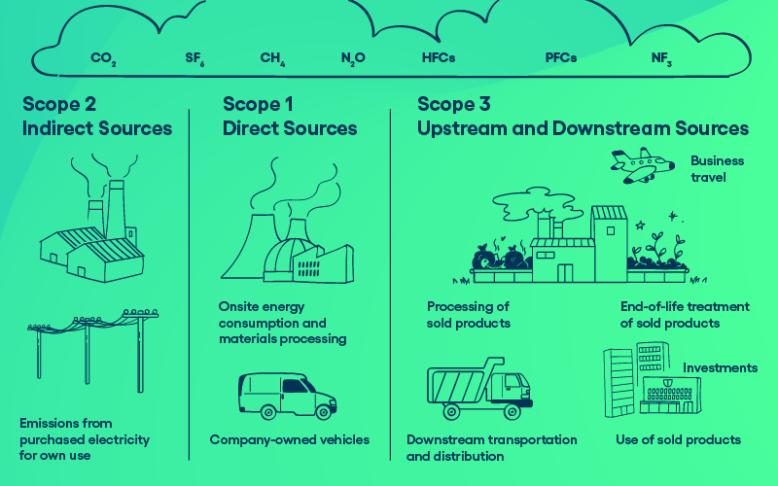10 Proven Strategies to Reduce Your Carbon Footprint
Climate change isn't just an environmental issue; it's a business imperative. Organizations worldwide are searching for effective ways to reduce their carbon footprint while maintaining operational excellence.
Whether you're just starting your sustainability journey or looking to enhance existing initiatives, understanding how to reduce your carbon footprint can transform both your environmental impact and your bottom line.
From optimizing energy consumption to implementing intelligent asset management systems, businesses today have more tools than ever to lower carbon footprint easily and effectively. And we’ve compiled some of the most practical and actionable strategies for you to start using today. But first...
What is a carbon footprint?
A carbon footprint measures the total greenhouse gas emissions caused by an individual, organization, event, or product. For businesses, this includes direct emissions from operations (Scope 1), indirect emissions from purchased energy (Scope 2), and all other indirect emissions in your value chain (Scope 3). Understanding your baseline is the first step in learning how to reduce carbon footprint effectively.

How to reduce your carbon footprint
Before diving into ways to reduce your carbon footprint, it's important to understand why this matters beyond environmental responsibility:
First, there’s the obvious: cost savings. Energy efficiency improvements typically reduce operational costs by 15-30%. But there’s more than just money to be saved. Other benefits of carbon reduction include:
- Enhanced regulatory compliance: Stay ahead of evolving environmental regulations and reporting requirements
- Stronger brand and reputation: Meet growing stakeholder expectations for environmental stewardship
- Improved risk mitigation: Reduce exposure to carbon pricing and climate-related business risks
- A stronger competitive advantage: Differentiate your organization in an increasingly sustainability-conscious market
Organizations that prioritize ways to reduce their carbon footprint often discover that sustainability and profitability go hand in hand.
Now, onto 10 simple and actionable tips for reducing your carbon footprint.
1. Measure and track your emissions baseline
You can't manage what you don't measure. The first step in any strategy to reduce carbon footprint is understanding your current emissions across all sources. Some key ways to do this are:
- Conducting a comprehensive carbon audit covering Scope 1, 2, and 3 emissions
- Identifying major emission sources including energy consumption, transportation, and waste
- Establishing baseline metrics and set measurable reduction targets
- Implementing tracking systems to monitor progress over time
- Using data analytics to identify emission hotspots and optimization opportunities
Research shows that organizations that measure their carbon footprint are 3x more likely to achieve meaningful reductions. That's because data-driven insights often reveal the highest-impact areas for improvement.
2. Optimize energy efficiency across your facilities
Energy efficiency is one of the most effective ways to reduce carbon footprint while simultaneously cutting costs. Here are some practical energy efficiency strategies you can implement:
- Replace outdated HVAC systems, lighting, and machinery with ENERGY STAR certified alternatives
- Reduce heating and cooling demands through better insulation and weatherization
- Implement programmable thermostats and regular maintenance schedules
- Switch to LED bulbs which use 75% less energy than traditional lighting
- Use IoT sensors and automation to optimize energy use in real-time
- Identify inefficiencies and prioritize improvements
Comprehensive energy efficiency programs have been shown to reduce facility energy consumption by 20-40%, directly lowering carbon emissions.
3. Transition to renewable energy sources
Switching to renewable energy is one of the most impactful ways to reduce your carbon footprint, particularly for Scope 2 emissions. Some renewable energy options you can consider include:
- On-site solar installations: Generate clean electricity directly at your facilities
- Renewable energy procurement: Purchase renewable energy through your utility provider
- Power Purchase Agreements (PPAs): Lock in long-term renewable energy contracts
- Renewable Energy Certificates (RECs): Support renewable energy development while offsetting your consumption
- Wind energy partnerships: Explore wind power options in suitable locations
4. Implement intelligent asset management
How you manage your physical assets directly impacts your ability to reduce carbon footprint. Intelligent asset management optimizes equipment performance, extends asset life, and minimizes energy waste. That includes:
- Preventive maintenance programs: Well-maintained equipment operates more efficiently and uses less energy
- Predictive analytics: Identify potential failures before they cause energy-intensive emergency repairs
- Asset performance optimization: Use data insights to operate equipment at peak efficiency
- Lifecycle planning: Make informed decisions about when to repair versus replace aging, inefficient assets
- Connected asset monitoring: Track real-time energy consumption and performance metrics
Organizations using intelligent asset management software have been shown to report15-25% reductions in energy consumption from optimized equipment performance.
5. Optimize transportation and logistics
Transportation often represents a significant portion of business carbon footprints. Here are ways to reduce carbon footprint in your supply chain and business travel
- Use logistics software to minimize travel distances and fuel consumption
- Transition company vehicles to electric or hybrid alternatives
- When electric isn't viable, choose the most fuel-efficient options available
- Reduce transportation frequency through better planning
- Decrease commuting emissions by enabling flexible work arrangements
- Encourage employees to use public transportation, cycling, or carpooling
- Replace unnecessary business travel with video conferencing
6. Reduce waste and embrace circular economy principles
Waste reduction is among the most overlooked ways to reduce your carbon footprint, yet it offers substantial environmental and financial benefits. Here are some practical waste reduction and circularity strategies you can start implementing today:
- Implement recycling for paper, plastics, metals, and electronics
- Divert organic waste from landfills where it generates methane
- Identify waste streams and opportunities for reduction
- Create products built to last, reducing replacement frequency
- Extend product lifecycles through repair and refurbishment
- Work with vendors to reduce packaging and implement take-back programs
- Reduce paper consumption through digitization
Effective waste reduction programs can decrease waste-related emissions by significantly while reducing disposal costs. And they’re among the easiest to get up-and-running.
7. Engage employees in sustainability initiatives
Your employees are essential partners in efforts to reduce your carbon footprint. Engaged teams can multiply the impact of your sustainability programs. Consider these employee engagement strategies:
- Educate your staff on why and how to reduce carbon emissions with the other initiatives you’re running
- Create cross-functional groups to champion sustainability initiatives
- Reward employees for sustainability contributions and ideas
- Share progress, challenges, and wins regularly
- Give employees tools and authority to make sustainable choices
- Celebrate individuals and teams driving carbon reduction
8. Leverage technology and data analytics
Modern technology provides unprecedented opportunities to reduce carbon footprint through intelligent monitoring, management, and optimization. Here are some modern digital tools that can help you make progress with your sustainability goals:
- Energy management systems: Monitor and optimize energy consumption in real-time
- IoT sensors: Track environmental conditions and equipment performance
- AI-powered analytics: Identify patterns and optimization opportunities humans might miss
- Carbon accounting software: Automate emissions tracking and reporting
- Building management systems: Integrate HVAC, lighting, and other systems for holistic optimization
- Asset management platforms: Optimize equipment lifecycles and performance
Data-driven carbon management enables continuous improvement and have been shown to deliver 25-35% better results than manual approaches.
9. Optimize water usage and management
While often overlooked in carbon discussions, water management is one of the most important ways to reduce your carbon footprint, as water treatment and heating require significant energy. Here are some strategies to consider:
- Install water-efficient faucets, toilets, and equipment
- Identify leak detection programs to identify and repair water leaks promptly
- Capture and use rainwater for non-potable needs
- Review industrial processes for water efficiency opportunities
- Improve efficiency in water-intensive cooling systems
10. Partner with sustainable suppliers
Your supply chain represents a significant portion of your total carbon footprint. Collaborating with suppliers on sustainability is essential to reduce carbon emissions comprehensively. Some sustainable supply chain practices to consider include:
- Supplier sustainability assessments: Evaluate vendors on environmental performance
- Carbon reduction requirements: Include sustainability criteria in procurement decisions
- Collaborative improvement programs: Work with key suppliers to reduce their emissions
- Local sourcing: Reduce transportation emissions by sourcing closer to operations
- Sustainable materials: Prioritize suppliers using recycled, renewable, or low-carbon materials
- Supply chain transparency: Track and report Scope 3 emissions throughout your value chain
For many organizations, supply chain emissions represent a majority of their total carbon footprint. That makes supplier engagement one of the most critical and effective ways to improve your sustainability outcomes.
Creating your carbon reduction implementation plan
Understanding ways to reduce carbon footprint is just the beginning. Here's how you can start with an actionable implementation plan:
0-3 Months: Foundation Phase
Begin by conducting a comprehensive carbon footprint assessment to understand your organization’s current environmental impact. Identify immediate “quick wins” that can produce early momentum, such as energy or waste reductions. Secure leadership buy-in and the necessary resources to ensure success, while establishing clear baseline metrics and tracking systems.
3-6 Months: Quick Wins Phase
With a foundation in place, implement energy efficiency improvements and launch employee engagement programs to build a culture of sustainability. Focus on optimizing existing asset performance to extend lifespans and reduce waste. Begin evaluating suppliers on sustainability criteria and establish a regular reporting cadence to monitor progress and maintain accountability.
6-12 Months: Strategic Initiatives Phase
Move from quick wins to longer-term strategic initiatives. Execute major energy efficiency upgrades and begin transitioning to renewable energy sources where feasible. Deploy asset management technologies that provide data-driven insights to support sustainability goals. Expand waste reduction programs across operations and formalize comprehensive sustainability policies to guide future decision-making.
12-24 Months: Transformation Phase
By this stage, your organization should be achieving measurable carbon reduction targets and embedding sustainability into every business process. Expand circular economy initiatives that repurpose or recycle resources to minimize waste. Pursue third-party verification or certifications to validate progress and enhance credibility. And finally, set the next generation of reduction goals to continue driving improvement and long-term environmental performance.
Measuring success of your KPIs
To effectively reduce carbon footprint, set and track key performance indicators like these over time:
Primary carbon metrics:
- Total carbon emissions across Scopes 1, 2, and 3
- Emissions per unit of production or revenue
- Year-over-year emissions reduction rates
- Percentage of energy from renewable sources
Operational efficiency metrics:
- Energy consumption per square foot
- Percentage of waste diverted from landfills
- Total water consumption and efficiency trends
- Transportation emissions per mile or per delivery
Business impact metrics:
- Cost savings from efficiency improvements
- ROI on carbon reduction initiatives and sustainability investments
- Level of adherence to environmental regulations
- Perception of sustainability efforts and outcomes from both internal and external stakeholders
Conclusion
Learning how to reduce your carbon footprint isn't just about environmental responsibility; it's about building a more efficient, resilient, and competitive organization. The 10 simple ways to reduce your carbon footprint outlined in this guide provide a comprehensive roadmap for meaningful action.
Start with measurement to understand your baseline. Implement quick wins like energy efficiency improvements to build momentum. Engage your employees to multiply impact. Leverage technology to optimize performance. And remember: every step toward reducing carbon footprint delivers both environmental and business benefits.
Ready to reduce carbon footprint with intelligent asset management? Discover how Brightly's software helps organizations optimize asset performance, reduce energy consumption, and achieve sustainability goals. Learn more about our energy and sustainability solutions. And check out our blog on How to Calculate Your Business’ Carbon Footprint.



